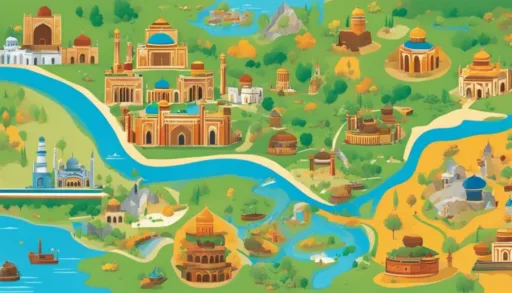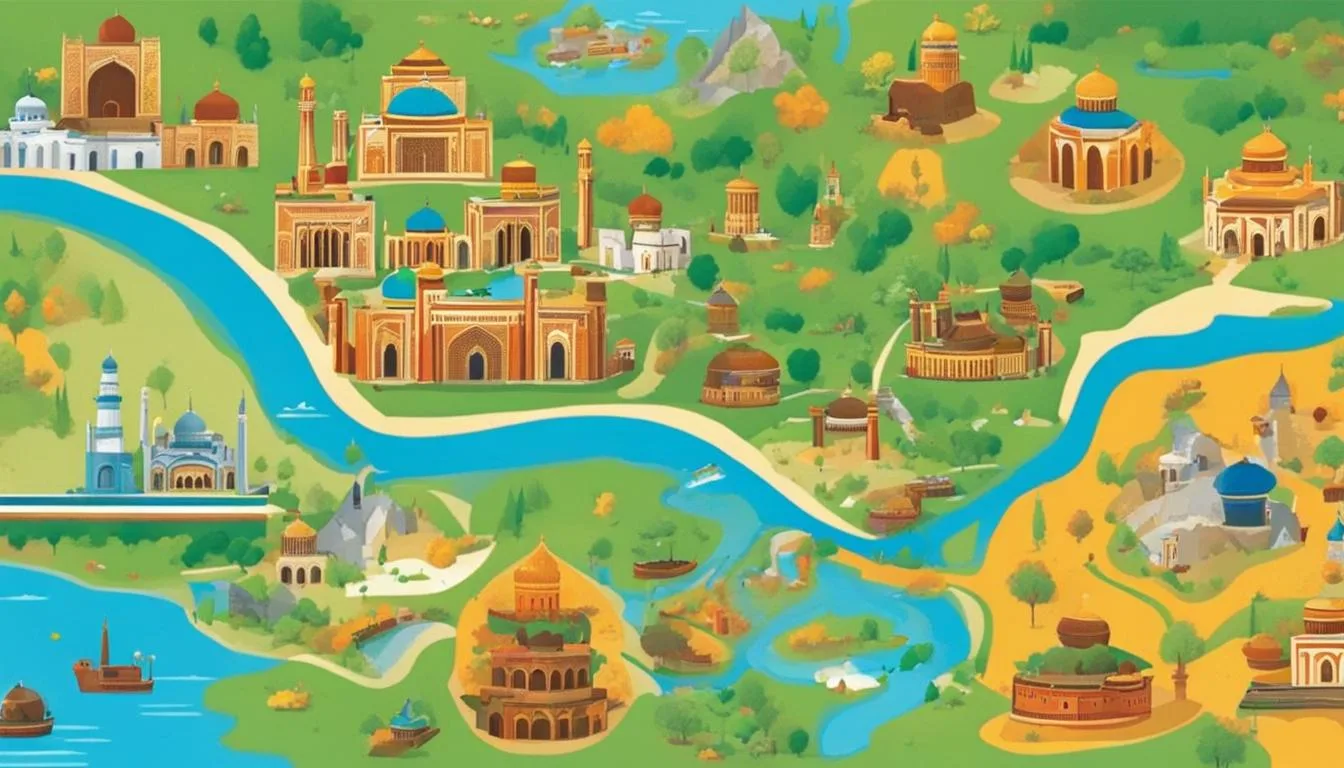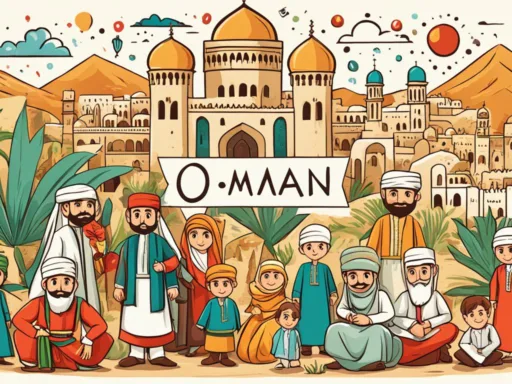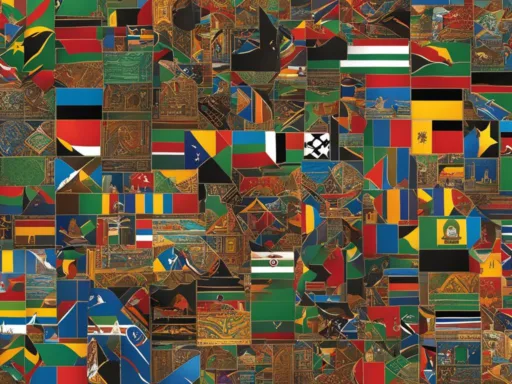Consider this: within the borders of Uzbekistan, a Central Asian nation of approximately 33 million people, you can hear a fabric of over a hundred different languages and dialects being spoken. This extraordinary linguistic diversity is a testament to the country’s vibrant cultural history and its position as a crossroad of civilizations. From the majority Uzbek language, which is a Turkic tongue, to a palette of minority languages and dialects, the languages spoken in Uzbekistan showcase an incredible span of Uzbekistan language diversity and distribution. This rich linguistic landscape not only reflects the country’s past but continues to shape its societal dynamics and interactions today.
Key Takeaways
- Uzbekistan’s linguistic tapestry includes over a hundred languages and dialects, mirroring its complex history and cultural diversity.
- The Uzbek language, a Turkic language, is the majority tongue and is officially written in Latin script since 1992.
- Despite having no official status, Russian is widely used, particularly in urban areas and in various spheres of public life in Uzbekistan.
- Karakalpak enjoys an official status within its own republic, contributing to the nation’s recognition of its linguistic landscape.
- The presence of other minority languages, like Kazakh and Kyrgyz, as well as the historic influence of the Persian language, underscore the Uzbekistan language distribution.
- The linguistic diversity of Uzbekistan reflects the country’s societal values, with notable implications for interethnic communication and education.
Exploring the Linguistic Landscape of Uzbekistan
The linguistic tapestry of Uzbekistan offers an intriguing journey through its historic pathways and culturally diverse society. The Central Asian nation’s linguistic mosaic is comprehensive, offering insights into the everyday lives of its people and reflecting the various influences imprinted over time. In this exploration, we uncover the multitude of tongues that construct the vibrant linguistic landscape of Uzbekistan.
Uzbekistan’s Multilingual Society
The essence of the country’s identity lies in not just one language but in the plethora of languages spoken across its land. Languages of international ties, trade, and regional dialects weave together to form the intricate social fabric of Uzbek society. The array of common languages in Uzbekistan spans Eurasian expanses, ties old with new, and signifies broad strokes of cultural heritage.
The Predominance of the Uzbek Language
While the ubiquity of the native Uzbek language speaks to its historical significance, acknowledging the linguistic diversity involves more than just recognizing the dominant. The narrative of linguistic diversity in Uzbekistan is punctuated by numerous minority languages that thrive alongside Uzbek. With an emphasis on cultural preservation and interethnic harmony, Uzbekistan’s language policies exemplify the respect and encouragement of all languages within its borders.
Below is a representation of the languages contributing to the vibrant linguistic scene in Uzbekistan:
| Language | Classification | Regions Spoken | Significance |
|---|---|---|---|
| Uzbek | Turkic | Nationwide | Official Language of State |
| Russian | Slavic | Largely in urban areas | Lingua Franca for inter-ethnic communication |
| Karakalpak | Turkic | Republic of Karakalpakstan | Symbol of regional identity |
| Tajik | Indo-Iranian | Samarkand, Bukhara | Bearer of Persian historical influence |
| Kazakh | Turkic | Northwestern regions | Reflects cross-border ethnic ties |
While Uzbek prides itself as the linchpin of the national language framework, the sustained vitality of other languages illustrates the multiethnic composition and the inclusive stance towards the linguistic landscape of Uzbekistan.
Unpacking the Official Languages of Uzbekistan
In the heart of Central Asia lies Uzbekistan, a nation where language acts as both a pillar of national identity and a bridge for intercultural communication. The intricate balance of language use within the country reflects its complex stance on bilingualism and multilingualism in public life. Let’s delve into the official languages of Uzbekistan and the nuances behind its language policy.
Uzbek – The State Language
As the hallmark of the nation’s identity, Uzbek is the state language of Uzbekistan, a status that is enshrined within the country’s constitution. Used prolifically across all strata of government and official communications, it maintains a dominant position in fostering a sense of unity and national pride. Public education, media broadcasts, and legislative proceedings predominantly employ Uzbek, aligning with the country’s objectives to fortify its linguistic heritage.
Role of Russian in Official Communication
Despite the prominence of Uzbek, the Russian language holds a consequential role within the Republic. With its semi-official status, Russian has become indispensable in various segments of government operations, including notary services and international intergovernmental affairs. This reflection of the Uzbekistan language policy demonstrates an astute recognition of the historical impact Russian has had and continues to have on the region.
This dual language framework effectively articulates the multifaceted official languages Uzbekistan adopts in its pursuit of a cohesive yet diverse linguistic strategy. As policies evolve and adapt to global influences, the intricacies of language use in Uzbekistan’s public sphere remain a fascinating subject for linguists and cultural observers alike.
The Turbulent History of Uzbek Language Scripts
The rich tapestry of Uzbekistan language history is vividly illustrated through the dynamic shifts in its written scripts. Initially steeped in the ancient traditions of the Persian script, the Uzbek language was subject to sweeping changes that mirrored the region’s complex geopolitical saga. As we trace the language evolution in Uzbekistan, it is evident that each script change brought with it a reshaping of cultural and national identity.
From Persian to Latin and Cyrillic
Uzbekistan’s linguistic journey began with the intricately designed Persian script, an emblem of its historical ties to the wider Persianate world. This script was utilized until the early 20th century, whereupon the winds of change blew in a new direction with the introduction of the Latin alphabet. This transition was brief, however, as the Cyrillic script was imposed by Soviet authorities in the 1940s, steadfastly embedding itself into the fabric of everyday life for the people of Uzbekistan.
Modern Adaptations: Reverting to the Latin Alphabet
In the throes of post-Soviet independence, Uzbekistan commenced a process of reclaiming its linguistic heritage by progressively reverting to the Latin alphabet. This deliberate move not only symbolizes a rekindling of cultural pride but also aims to facilitate the nation’s integration into the global community. Despite Cyrillic’s enduring prevalence among the older demographic and its usage in certain segments of traditional media, the educational emphasis is now firmly placed on the Latin script.
Education initiatives have had a profound impact on fostering a new generation of Uzbeks who navigate their cultural narrative with fluency in both the Latin script and the cherished vernacular of their ancestors. This bold stride into the future, anchored by deep roots in the past, highlights the relentless spirit of a nation dedicated to shaping its own destiny in the annals of history.
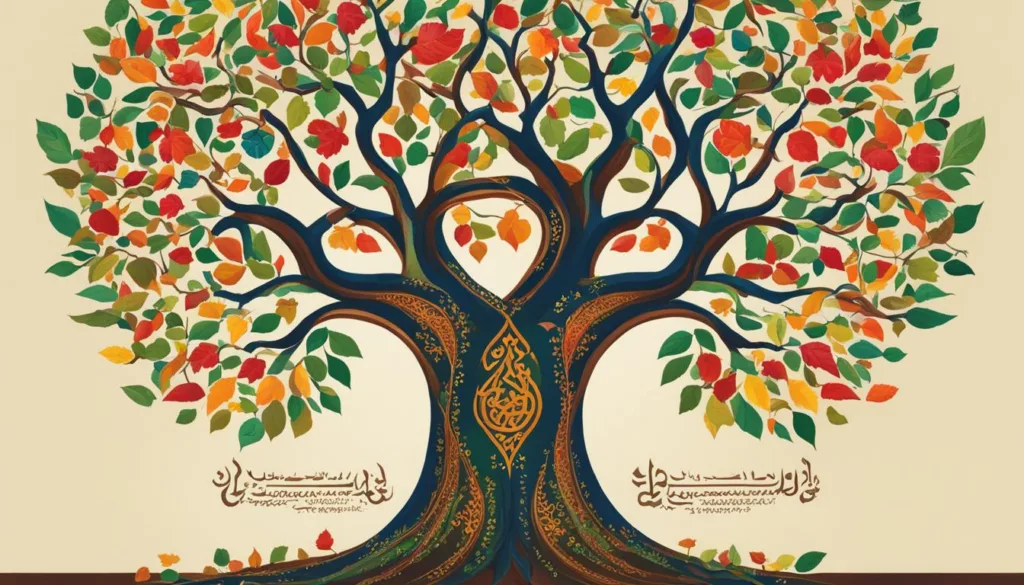
Languages Spoken in Uzbekistan: Beyond the Official Tongue
The exploration into the language diversity Uzbekistan showcases uncovers a tapestry rich with linguistic variance far surpassing the official Uzbek tongue. An intricate web of languages weaves itself through the bustling city streets of Tashkent to the historical crossroads of Samarkand and Bukhara, including a variety of minority languages Uzbekistan cherishes as part of its cultural heritage.
- Dungan – spoken by the Dungan people, primarily residing in various urban centres across the country.
- Koryo-mar – the language of the Koryo-saram, the ethnic Korean population within Uzbekistan.
- Kazakh – commonly heard in areas bordering Kazakhstan, showcasing the fluidity of cultural and linguistic boundaries.
- Persian – its historical and continued significance echoes through the corridors of Bukhara and Samarkand, adding depth to Uzbekistan’s linguistic map.
Despite their smaller speaker base, these languages contribute indispensably to the language diversity Uzbekistan is known for, enriching the country’s socio-cultural framework and endowing it with a fascinating array of linguistic expressions.
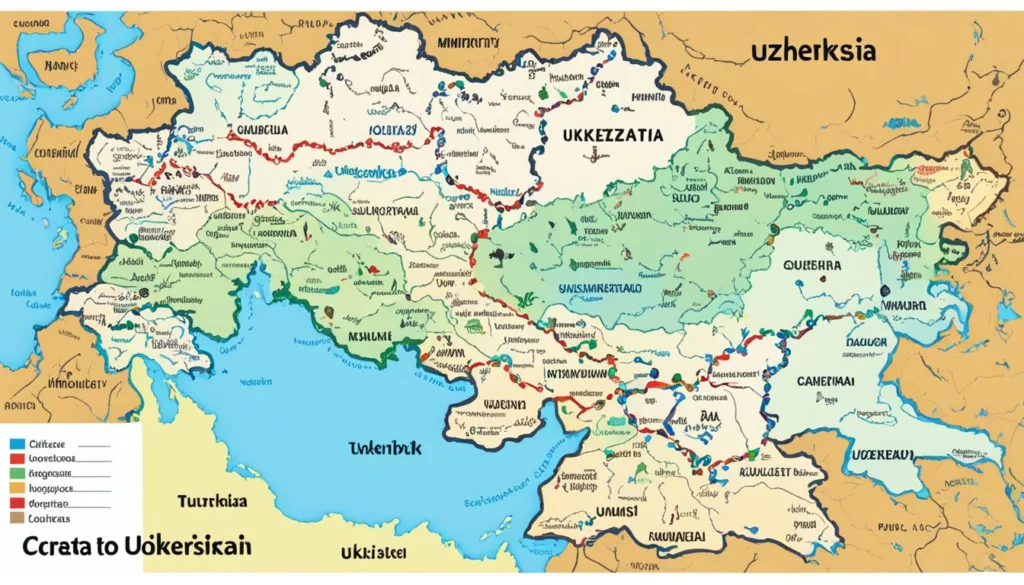
| Language | Speaker Population | Regions Spoken | Notes |
|---|---|---|---|
| Dungan | Approx. 7,000 | Urban Centres | Of Chinese origin, the Dungan people found refuge in Uzbekistan in the late 19th century. |
| Koryo-mar | Approx. 150,000 | Across Uzbekistan | Language of the Korean community, reflects the migration during the Soviet era. |
| Kazakh | Approx. 800,000 | Near Kazakhstan border | Affinities with Uzbek allow for intercommunication between Kazakh and Uzbek speakers. |
| Persian | Not specified | Bukhara, Samarkand | An essential language of historical scholarship and trade, still prevalent in cultural practices. |
It is evident that the rich language diversity Uzbekistan prides itself on goes well beyond its majority population’s language. Minority languages in Uzbekistan, while making up a smaller fraction of the voice, play a crucial role in telling the full story of Uzbekistan’s dynamic, plurilingual landscape.
Russian Influence and Usage in Uzbekistan
While Uzbekistan’s language landscape is predominantly defined by its national language, Uzbek, the Russian language continues to hold significant sway within the country. The historical ties between the two nations have cemented the Russian language in Uzbekistan not only as a tool for communication but also as an enduring cultural presence.
The Semi-official Status of Russian
Having a semi-official status, Russian is a cornerstone for interethnic dialogue and a critical element within the domains of governmental operations, the sciences, and commerce. This facilitation aids various ethnic groups in Uzbekistan to collaborate and thrive together in a multi-lingual society.
Russian in Culture and Intergenerational Use
Russian’s imprint on Uzbekistan’s culture and society spans generations. Elder members of the community often utilize Russian in their daily routines and consume media in the language, thereby maintaining its prevalence. However, in urbanized areas, there’s an observable shift with the youth demonstrating a trend towards lesser fluency, indicative of evolving linguistic preferences over time.

Minority and Regional Languages Within Uzbekistan
Uzbekistan, a nation celebrated for its cultural richness and ethnic diversity, offers a fascinating linguistic mosaic beyond its primary language, Uzbek. Here, the vibrancy of cultural identities is often expressed through the region’s speech — an auditory testament to the heritage and stories of its people.
Karakalpak: Cultural Identity and Language Preservation
In the autonomous republic of Karakalpakstan, the Karakalpak language holds its ground as an emblem of regional identity. Recognized with official status, this language is not just a communication tool but a bastion of cultural heritage, embodying centuries of history, traditions, and the Karakalpak people’s quest for linguistic preservation amidst modernity’s relentless tide.
Other Minority Languages: A Glimpse Into Diversity
The linguistic landscape of Uzbekistan is further enriched by the myriad of other minority and regional languages. Among them, Kyrgyz and Southern Uzbek stand out, each genre representing an essential thread in the tapestry that forms Uzbekistan’s cultural quilt. They serve not merely as means of communication but as repositories of collective memory, oral literature, and identity for the respective ethnic groups—a true reflection of regional languages in Uzbekistan.
- Kyrgyz: Predominantly spoken by the Kyrgyz minority, the language maintains its relevance by being passed on through generations in select regions.
- Southern Uzbek: Differentiated slightly from the more widely spoken Northern variant, it adds to the distinct linguistic flavors within national borders.
These minority languages in Uzbekistan contribute profoundly to the nation’s linguistic diversity, each adding their unique essence to the rich cultural dialogue celebrated throughout the region.
The Role of Foreign Languages in Uzbek Society
The cultural tapestry of Uzbekistan is continuously enriched by foreign languages, with English standing out as a rapidly developing means of global interaction. Acknowledging the importance of English language in Uzbekistan, educational reforms and market demands reflect a conscious movement towards adopting this world language, especially in strategic areas like business and tourism.
English as an Emerging Foreign Language
Spotlighting the trend, the younger demographics in Uzbek society are increasingly inclined to learn English. This shift is driven by the recognition that proficiency in English opens up doors to broader career opportunities and deeper engagement with the international community. Educational institutions in Uzbekistan are adapting to this demand by incorporating English language programs and exchanges in their curricula, catering to a generation keen on global participation.
Greater Need for English in Trade and Tourism
The burgeoning sectors of trade and tourism are also catalyzing the adoption of the English language in Uzbekistan. As the country positions itself as a central hub on the Silk Road, the proficiency in foreign languages in Uzbekistan, especially English, has become indispensable. Tour operators, hoteliers, and businesses are seeking to accommodate and attract a more international clientele, emphasizing the necessity for English language skills in these key areas of Uzbekistan’s economy.
Overall, while Uzbek and Russian maintain a strong presence, the impetus to learn English signals Uzbekistan’s ambition to engage more effectively on the global stage. It highlights an ongoing transformation within the society, where English competence is increasingly viewed not just as an educational goal but also as a bridge to the wider world.
Uzbekistan’s Language Policy and Education
As Uzbekistan strides forward in fostering a cohesive national identity, a pivotal component of this growth is evident through its language policy and educational system. The frameworks in place both preserve the linguistic heritage of the nation, and reflect an openness to the global community through the implementation of diverse language education.
Language Policy: Balancing National Identity and Diversity
The nation’s language policy is a testament to a nuanced balance between promoting the Uzbek language and embracing the ethnic and linguistic variety that characterizes the country. Key to this balancing act is the recognition that language is not just a tool for communication but also a cornerstone of cultural identity and national unity.
Educational System’s Approach to Multilingualism
In Uzbekistan’s classrooms, an air of inclusivity prevails, with curricula thoughtfully designed to accommodate multiple languages. Reflective of a commitment to multilingualism, Uzbekistan language education is not limited to proficiency in the national language alone but extends to several other languages, facilitating a well-rounded linguistic competency that students carry into the future.
The integration of various languages into the educational fabric of Uzbek society serves as a practical response to the evolving dynamics of global communication, recognizing the importance of languages like English and Russian in addition to regional tongues. The following table highlights the key elements of Uzbekistan’s language education system.
| Language | Role in Curriculum | Level of Proficiency Aimed |
|---|---|---|
| Uzbek | Primary language of instruction | Advanced proficiency for all students |
| Russian | Common second language | Functional proficiency for interethnic communication |
| English | Key foreign language | Practical proficiency for global engagement |
| Karakalpak | Regional language in Karakalpakstan | Competency for cultural preservation |
| Other Minority Languages | Optional subjects | Basic understanding to promote diversity awareness |
This strategic approach unites the dual objectives of Uzbekistan language policy: fostering a distinctive national identity while simultaneously equipping citizens with the linguistic skills necessary to participate in a global society. The implications of this policy are far-reaching, promising to imbue future generations with both the pride of their cultural heritage and the tools for international diplomacy and commerce.
Understanding the Distribution of Languages in Uzbekistan
The rich tapestry of Uzbekistan’s linguistic heritage is vividly illustrated in the varying language distribution patterns that define urban and rural landscapes. The contrasting linguistic scenes between these regions not only highlight the country’s diverse cultural dimensions but also mirror the complexities of its historical lineage. To fully grasp the extent of this cultural phenomenon, one must delve into the distinct linguistics trends that are characteristic of the country’s metropolises as opposed to its countryside.
Urban vs Rural Linguistic Trends
Within the bustling hubs of Tashkent, Samarkand, and Bukhara, a cosmopolitan confluence emerges, predominantly showcasing Uzbek and Russian as the principal languages. This urban linguistic blend is a direct consequence of both historical Soviet influence and the pragmatic needs of modern commerce and governance that necessitate fluency in these languages. In contrast, the rural vistas of Uzbekistan paint a different picture, playing host to a medley of minority languages that are spoken within tight-knit communities, preserving their unique cultural identities and ancestral connections.
Persian’s Presence in Historical Regions
In storied locales such as Samarkand and Bukhara, the Persian language in Uzbekistan marks its resonance, serving not merely as a mode of communication but as a vivacious testament to the regions’ storied pasts. Persian echoes through the corridors of ancient architecture and suffuses the cultural essence of local traditions, signifying a living bridge to a time-honored heritage that has withstood the test of time. The enduring presence of Persian is emblematic of Uzbekistan’s language distribution, capturing the intrinsic bond between language and historical identity.
FAQ
What are the most commonly spoken languages in Uzbekistan?
The most commonly spoken language in Uzbekistan is Uzbek. Russian also serves as a de facto second language, particularly in urban areas and for interethnic communication.
How does Uzbekistan’s language diversity manifest in everyday life?
Uzbekistan’s language diversity is evident through the mix of languages spoken across the country. This includes minority languages such as Dungan, Kazakh, Kyrgyz, and Persian in addition to Uzbek and Russian, contributing to a rich linguistic tapestry within various communities.
Are there regional languages spoken within Uzbekistan?
Yes, Karakalpak is the official regional language in the Republic of Karakalpakstan, and it has a status similar to that of the state language within the region.
Does Uzbekistan have a language policy?
Indeed, Uzbekistan has a language policy that officially recognizes Uzbek as the state language. The policy also acknowledges the importance of Russian and allows for the protection and use of minority languages.
Has the Uzbek language always been written in the Latin script?
No, the Uzbek language has undergone script changes throughout history. It was originally written in the Persian script, then changed to Latin in the early 20th century, switched to Cyrillic during the Soviet era, and has reverted to Latin script since 1992.
Is English widely spoken in Uzbekistan?
English is an emerging foreign language in Uzbekistan, particularly among the younger generation and in larger cities. Its popularity is growing due to increased interest in global communication, trade, and tourism.
What role does Russian play in Uzbekistan’s linguistic landscape?
Russian has a significant role as it’s widely used in government, business, and technical fields. While not officially recognized as a state language, Russian is commonly understood and spoken, especially by the older generations.
How does the educational system in Uzbekistan address language diversity?
The educational system in Uzbekistan aims to balance national identity with the country’s linguistic diversity. Schools typically offer instruction in Uzbek, with opportunities to learn Russian and other minority or foreign languages.
What are the differences in language distribution between urban and rural areas in Uzbekistan?
Urban areas in Uzbekistan tend to have a higher prevalence of Uzbek and Russian speakers, reflecting a more linguistically homogeneous environment. Rural regions often showcase a greater diversity of minority languages, contributing to a multilingual landscape.
Can foreigners get by with English in Uzbekistan?
While knowledge of English is growing, particularly in tourist areas and larger cities, it’s not as widespread as Uzbek or Russian. Learners of English are more common among younger, urban populations, and it is helpful in international business contexts.
